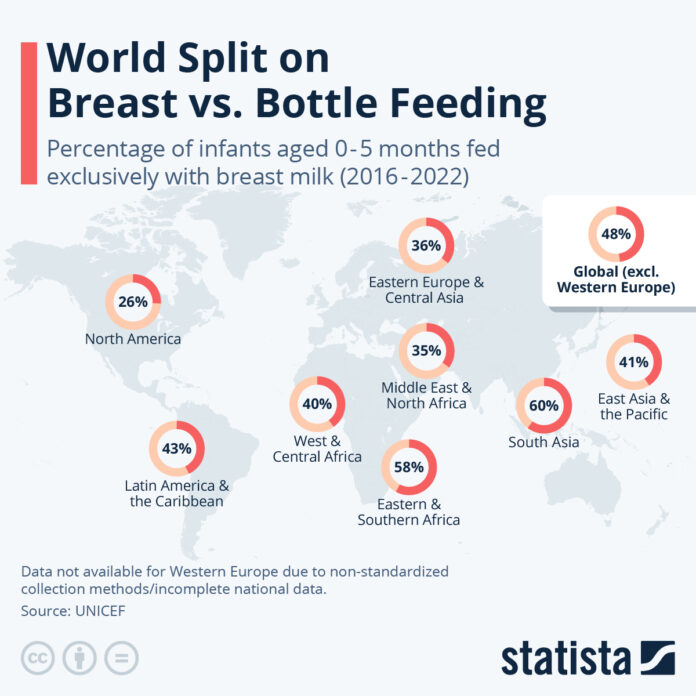Breast Or Bottle? China Is The Global Market For Infant Formula
In a press release published ahead of World Breastfeeding Week (August 1 to 7), the World Health Organization (WHO) reports that:
“Over the past twelve years the number of infants under 6 months who are exclusively breastfed increased by more than 10 percent globally. Now, almost half (48 percent) of infants worldwide benefit from this excellent start in life”.
But this progress needs to be put into perspective if we take into account sales of breast milk substitutes, which have more than doubled worldwide over the last twenty years. Additionally, while countless studies have found the benefits of breastfeeding, others have claimed that when you eliminate selection bias, i.e. richer women being more likely to breastfeed, the positive effects almost disappear as larger socioeconomic factors overlay the still substantial benefits that breast milk does have.
Breastfeeding is sure to provide all the nutrients and energy needed for the growth and development of newborns and provides immune protection and other benefits through bioactive ingredients that formula doesn’t have.
In developing countries, water safety is another factor that makes breast milk the superior option, while of course, the small chance of formula itself being contaminated also remains a risk.
However, the product is still marketed aggressively around the world, using with exaggerated claims to its benefits – something that has been criticized widely together with the baby milk industry’s high spending on lobbying.
The WHO recommends exclusive breastfeeding until the age of 6 months and continued breastfeeding (with appropriate complementary feeding) until 2 years or more. However, apart from the response to marketing, not exclusively breastfeeding can have many reasons, including the mother working, personal reference, division of labor considerations and physical issues breastfeeding.
As Statista’s Katharina Buchholz shows in the chart below, based on UNICEF data, the regions where breastfeeding is most prevalent are South Asia and Eastern and Southern Africa, where around 60 percent of infants aged 0 to 5 months are exclusively breastfed.

You will find more infographics at Statista
Conversely, breastfeeding rates up to 6 months are lowest in North America (26 percent) and Eastern Europe and Central Asia (36 percent). For Western Europe, this data is not available due to the lack of a standardized collection method and incomplete national data, but breastfeeding rates are generally low across Europe.
However, despite the high rate of breastfeeding in Asia, China is the biggest market worldwide for baby milk and infant formula.
In 2024, Statista Market Insights estimates that sales will reach almost $17 billion in the country. The second biggest market, the United States, is far behind at just $6.2 billion. However, per-capita spending was higher in the U.S. and actually lowest in China out of the top 5 biggest markets. Numbers by UNICEF show that the use of formula is more widespread in more developed countries and has also become typical in China’s burgeoning middle class, while it hasn’t caught on everywhere in the nation – explaining the lower per-capita spending.
You will find more infographics at Statista
Like in other nations, families in China are subject to aggressive baby formula marketing and urban Chinese women were found to have the highest exposure to respective advertising messages in a recent survey.
Due to its high price, the global market for baby formula is large at almost $54 billion.
The above survey also names Vietnam as a country saturated with such marketing. It was identified as the fifth biggest formula market by Statista, while another Asian nation, Indonesia, came in rank 3. Out of the top 5, Vietnam exhibited the highest estimated per-capita spending on infant formula given that estimates say only 17 percent of babies there are exclusively breastfed for the first six months of their lives.
Tyler Durden
Fri, 08/09/2024 – 20:30
